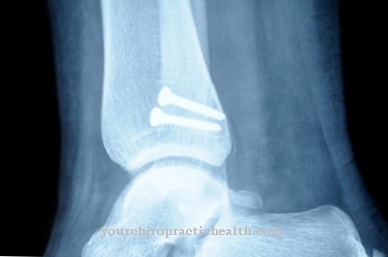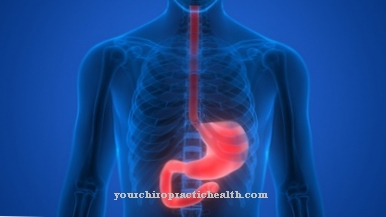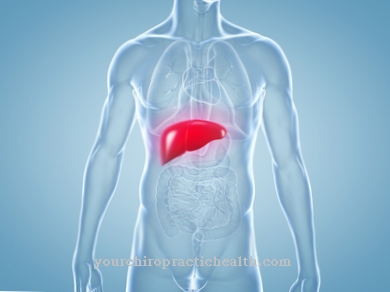If toxins get into the human organism through diet or other environmental influences and these cannot be excreted, inflammation occurs. Regenerating the intestinal mucosa can stop the inflammatory process, because when the intestinal mucosa no longer releases the inflammatory substances into the body, the Inflammatory metabolism stopped.
What is the inflammatory metabolism?

Not all toxins that a person ingests can be eliminated from the human body through the intestines, skin or breath. Toxic substances are mainly deposited in the intestinal mucosa, where an inflammation begins a little later. The intestinal flora is then no longer intact.
In order to stop the inflammatory metabolism, the environment in the intestine must be regenerated. Due to the so-called "leaky gut syndrome", the toxic substances not only remain in the intestines, but are distributed throughout the entire organism and can affect human health.
Function & task
The intestinal flora is essential for human health. An unhealthy diet, frequent use of antibiotics or stress can cause immense damage to the natural intestinal flora, which leads to inflammation.
In order to regenerate the natural intestinal flora and eliminate the inflammatory metabolism, the basics of the lifestyle of those affected must be changed in order to achieve holistic treatment and complete recovery. It can take two years for the intestinal mucosa to regenerate. During this time, regular microbiological examinations of the patient are necessary in order to determine whether the intestinal environment is regenerating and the dangerous putrefactive bacteria disappear again.
The presence of the c-reactive protein, or CRP for short, is a medical indication of an inflammatory metabolism. The more of this protein is found in a blood count, the more inflammatory processes are currently taking place in the patient's body. The intestine deposits the inflammatory products in all suitable depots in the body, i.e. in muscles, connective tissue or fatty tissue, so that these substances cannot only be found in the intestine.
In adults, a CRP value of up to 0.5 mg / dl is considered normal. However, if the blood plasma or blood serum is examined with the Nyocard analyzer, a value of up to 1.0 mg / dl is no further cause for concern.
The CRP protein is needed in the human body to remove dead immune cells and inflamed tissue.However, the presence of CRP proteins alone is not an indicator of an inflammatory metabolism. It is formed by the liver in acute inflammations and, as a reaction to a fresh inflammation in the body, can increase its concentration in the blood by a factor of 1000 within a few hours - it is usually broken down again just as quickly.
If the blood count shows an increased CRP value, further research must be carried out to determine which inflammation is present in which part of the body. The concentration of the inflammatory molecules does not provide any meaningful evidence of this. Inflammation of the intestinal mucosa and changes in the intestinal flora are also examined by laboratory medicine with the help of a stool sample. Only the evaluation of all the findings allows a further treatment of the unspecific syndromes that an inflammatory metabolism entails.
Illnesses & ailments
If the intestinal flora is not intact and the intestinal mucosa is permeable, this must be treated. Because the unhealthy intestinal mucosa absorbs allergens, as these are not destroyed by the immune system. This leads to allergies and intolerance for those affected.
The addition of probiotic microorganisms can help regenerate the intestinal flora and eliminate inflammation by making the intestinal flora more stable and no longer permeable. Regeneration is a long process. Symptoms that an inflammatory metabolism can cause, according to some experts, are, for example, a migraine or various allergies.
Hay fever can also be related to the inflammatory metabolism, as the body tries to deposit the toxic substances in the mucous membranes as well. The immune cells become active there and are constantly busy with these substances. If an allergen, such as pollen, irritates the already irritated mucous membranes and hits the extremely active immune system there, the body's own T cells overreact.
The cause of pain or rheumatic diseases can also be explained by inflammation originating in the intestine. The toxins removed from the intestines lead to acidification of the body at high concentrations, which reacts with pain. A lack of concentration or permanent tiredness can also have similar causes. As these are unspecific causes, it makes sense to see a doctor.
An increased concentration of the inflammatory molecule CRP always requires clarification. Inflammation occurs with harmless infections or fever as well as with tumor diseases or other serious diseases. The value alone gives only an indication of inflammation, but is not sufficient for an accurate diagnosis. Further medical examinations are needed if there is evidence of inflammation in the body or an inflammatory metabolism. If there is an inflammatory metabolism, its treatment can take several months, since the regeneration of the intestinal flora is a long-term process.
























.jpg)



